I learned so much! Using sports as a lens to teach history, “not just a moment, a movement,” and all these athletes I haven’t heard of.
Mr. Zirin’s knowledge was both encyclopedic and engaging: it is rare to encounter such a capable historical scholar who is also a brilliant storyteller. I am booked through June for these wonderful online forums.
The format was really excellent, very accessible. The breakout groups came at the right time and it was nice to engage more with a small group and then return to the large group for more conversation.
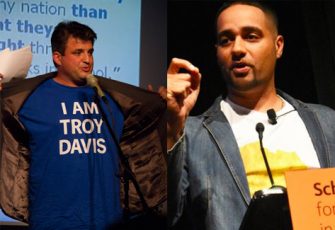 These are just a few comments from the more than 250 educators and students who participated in the People’s Historians Online mini-class on Black Athletes and the Black Freedom Struggle with Dave Zirin and Jesse Hagopian on May 15, 2020. On this page we offer session highlights, a video of the full session, resources recommended by the presenters and participants, and more participant reflections.
These are just a few comments from the more than 250 educators and students who participated in the People’s Historians Online mini-class on Black Athletes and the Black Freedom Struggle with Dave Zirin and Jesse Hagopian on May 15, 2020. On this page we offer session highlights, a video of the full session, resources recommended by the presenters and participants, and more participant reflections.
The talk is available as a podcast via The Nation, Black Athletes and the Civil Rights Movement.
Video
Video of the full event, except the breakout sessions.
Transcript
Click below for the full transcript with resources mentioned in the discussion.
Transcript
Jesse Hagopian: Thank you for joining us today. Welcome, on behalf of the Zinn Education Project for our session today on Black athletes and the Black Freedom Struggle. I am very excited today to introduce you all to Dave Zirin. He’s the author of many books, including A People’s History of Sports and one of my favorites, Things That Make White People Uncomfortable, which he co-authored with Michael Bennett. He is a regular columnist for The Nation and also a good friend of mine, who I met when I began my teaching career in Washington D.C. I’ve spent a lot of time on his couch watching sports and cheering and yelling at things. So, Dave, good to have you with us today, man.
Dave ZIrin: Great to be here. Thanks for having me.
Hagopian: No doubt. Thanks for joining us. Are you ready for this conversation? Alright, here we go. We’ve got a lot to talk about today. We’ve had such great discussions about the Civil Rights Movement and the Black Freedom Struggle, but today we’re going to talk about how it relates to sports. I just wanted to start with a reflection about sports and education as a teacher, because, I think, on the one hand sports saturate education, like they’re often the most visible part of any campus. At any school it’s what everybody rallies around. But, on the other hand, it seems to me that sports are often completely absent from the classroom. They’re not studied at all in the K–12 curriculum. I think it’s often seen as not a serious arena of study, right? They’re generally excluded from history class, from English, language arts, and science.
I remember, in 1995, one of the few times the Mariners ever made it to the playoffs, there was a one game playoff, and I was in the sixth period. I was listening to the game on one of those little trying to be slick ear devices on the radio, and when Luis Sojo got that inside-the-park home run to win the game for us, I leaped up on my desk, I was screaming, and I got in trouble for that moment. But reflecting back, I thought if we learned about the physics of baseball in that class, they wouldn’t have had to ask for my attention. I would have been right there. So, what’s going on with sports and education?
Zirin: Well, before we delve into that, I just want to say something about sports in this series that you guys have been doing. I think this does also start to answer that question, at least from the perspective of historians or social scientists out there. I would make the case that it is impossible to give a rounded and full picture of the Black Freedom Struggle — and specifically the movements of direct action to desegregate the Jim Crow South — without talking about sports.
Sports is a part of the story, and not just a part of the story in terms of having a Black athlete on the field — that changed people’s minds — but I’m talking about actual direct action to fight Jim Crow. In 1960, Wilma Rudolph, who became an Olympic superstar after becoming the first woman to win three gold track and field medals, refused to have her parade or receptions in Clarksville, Tennessee, if they were segregated. This was actually the first instance of integration in the history of Clarksville, Tennessee. Not sit-ins, like we saw in Greensboro so famously, although those would come to Clarksville. But the first time there was integration was because Wilma Rudolph stood up and said, “No, you can’t celebrate me as an Olympian, or as a champion or as an athlete, and do it in the context of Jim Crow. I refuse that.” That happened in 1960. That’s when Wilma Rudolph did that, 1960. By 1966, six years later, you had the end of legal segregation in sports and the Jim Crow South. In six years. That’s an amazing speed of progress. Think about that.
Hagopian: Yeah, we don’t learn about any of that.
Zirin: No, and it’s an amazing speed of progress. So, how did it happen? How did this happen from 1960 to 1966, that profound change? One answer is obviously the broader climate, the broader movements of the Civil Rights Movement, and sports being a part of that in terms of like when facilities became desegregated, sports became a part of that. But, when we just see sports as a reflection of the Black Freedom Struggle, as a reflection of the Civil Rights Movement, it erases those struggles large and small to integrate sports.
I really want to recommend this book right here by Louis Moore called We Will Win the Day: The Civil Rights Movement, the Black Athlete, and the Quest for Equality, which is filled with all kinds of small stories that took place in small towns, maybe some of us haven’t heard of in the south, where sports was the impetus for desegregation. And sports was the site of direct action. The book, it’s such a good book, We Will Win the Day. It shows that all this integration happened not only because sports reflected larger trends, but for four reasons.
First of all, the NAACP and the Black press led boycotts of stadiums that had segregated seating, which cost the sports boss’s money. Second, there were pickets at the stadium of teams like the Boston Red Sox, which was the last team to integrate, and Major League Baseball and people were assaulted when raising their voices to integrate sports. Three, you have the courts with lawsuits to integrate sports. And four, and this is an interesting one: All white teams were tired of losing. That was most famously at the University of Alabama with Bear Bryant. Enough losing in the Southeastern Conference, even in the heart of Jim Crow, pushed for integration.
Then, just one last point, and this is where sports differs from say a lunch counter struggle, a sit-in, or a demonstration is that when it comes to sports, I would argue that there are two kinds of political athlete. You have the representative and you have the explicit. By representative athlete I mean athletes who changed the world just by taking the field or by the court. Think about Althea Gibson dominating the tennis world, that lily white country club sport. Just by taking the tennis court, she changed the world. That’s the representative; her play changed the world. But, by the explicit I’m talking about athletes who refuse to play unless there were integrated accommodations or stands. People who use their platform to speak out. These are the forerunners of Colin Kaepernick, if you will. All the people who use their hyper-exalted, brought-to-you-by-sponsors platform to actually say, “Wait a minute, I’m not going to play in the city of Houston if there are segregated accommodations. I’m not going to do that.” Then, actually, the city of Houston changed its local ordinances to host these games. That’s an untold story of the Black Freedom Struggle and it’s very exciting because it shows that culture — which I think sports is a part of — is a key motivator and key lever for social change.
Hagopian: Yeah, and I would have paid attention in my history class if you had gone through that. I wonder if other people also have noticed that sports are absent from K–12 schooling? So maybe we can put that poll up: Did you learn about Black athletes in the Black Freedom Struggle?
Zirin: I’ve taught a sports history class at Montgomery College here for the last couple of years, and one of the things I see is that a lot of students have no interest in history. But, when you teach history through the lens of sports, all of a sudden they’re picking it up, and their minds are just exploding. Now they want to know about the Cold War, they want to know about the women’s rights movement, they want to know about the LGBTQ movement, because talking about it through the lens of sports gives them something to hold on to and gives them a frame of reference.
Folks might be thinking, “Well, wait a minute. If you do that, don’t you exclude the students who don’t like sports?” My experience is that I really do believe that sports is for everybody and we shouldn’t feed the idea that sports are only for the select few. We should expand the idea that sports really are for everyone. The radicals in the late 1960s and early 1970s, on campuses, fought for things like universal physical education, for example, because they believed that sport shouldn’t be something for the chosen few, that we shouldn’t have this divide between those who play and those who watch, which is far too often the fundamental feature in our sports society.
Hagopian: No doubt. And women’s suffragettes also believed that riding the bicycle and taking the court was part of their liberation, as well, and reclaiming spaces that were pushed aside from them.
Zirin: The thing about sports, which makes it such a great tool, is that we’re taught that sports is this level playing field and that if you’re good enough, you get to play. Unfortunately, the whole history of the United States is that we don’t have a level playing field. So the battle by LGBTQ people, by women, by people of color, by Black Americans to actually have their place on the field has massive political ramifications because it holds a light to all the hypocrisy and contradictions of American society.
Hagopian: It is really electric when you expose those and talk about history through the lens of sports. I mean, I showed your video, Dave, Not Just a Game, I usually show it every year in my classrooms and some of those students who watch that video then led the entire Garfield High School football team in taking a knee and becoming the first high school in the country to have the entire team take a knee. It can be a really powerful lens to look at history through. I want to dive into this history . . .
Zirin: I have to write about Garfield; it’s such a great story. I’ve interviewed the coach who was there at the time, and one of the players now, for this book I’m doing about people who take knees during the anthem and what it means to them. I love that athletes connect with that history of sports and struggle. I love that so much because, as someone who was an athlete myself, you’re brought up through the sports system to think that the only thing you should do is say “Yes, sir,” “No, sir,” or “Yes, ma’am,” and “No, ma’am” to your coach. That’s the extent of what you’re allowed to say or what you’re allowed to do. Sports is seen as antithetical to politics when there’s this whole rich tradition that says otherwise.
Hagopian: Let’s dive into that tradition. Growing up, I revered Jackie Robinson as the first player to integrate the major leagues, at least in the modern era. Because, of course, Moses Fleetwood Walker, back in the 1800s, also played ball. Then I saw Spike Lee’s Malcolm X in high school, that movie, you know, I had to get the X hat. That movie really trends; it’s formed me and I was moved by it. In that film, it’s got Malcolm X dissing Jackie Robinson. He basically calls him an establishment figure who is shucking and jiving for white people. And it’s a white power structure that’s happy to integrate one Black face into their league without making structural changes. After learning more about Jackie’s trajectory, I’ve really come to a deeper appreciation of the role he played in helping to integrate sports and the Black Freedom Struggle in general. But, I’m hoping you could talk more about Jackie’s legacy and the integration of sports.
Zirin: There are so many Jackie Robinson’s that to speak about Jackie Robinson as one person does a disservice to the many twists and turns he took in his own intellectual and political life. Martin Luther King called Jackie Robinson “a sit-inner before sit-ins, a freedom rider before freedom rides.” I think that’s a good starting point for Jackie Robinson in that he comes into Major League Baseball as a World War II veteran, and for many Black Americans this symbol of hope — that after World War II, where the entire country was marshaled to defeat fascist countries in Nazi Germany, that we were reaching towards a place that was going to be less racist going forward and where the Constitution and its ideals of life, liberty, and the pursuit of happiness would be open for everybody — and Jackie Robinson was going to be the symbol for that going forward.
The reality that Jackie faced was something that was very similar to a lot of King’s philosophy a decade later, in that he was asked, he was really told, that if he was going to be that first player, he would have to turn the other cheek. He would have to take all kinds of abuse and he would have to be stoic in the face of that abuse as a way to be an example, not just for other Black players coming into Major League Baseball, but also for Black Americans who are watching. He was explicitly told, “You are a social figure, not just a baseball player, and you need to be an example for the Black masses, not only yourself.” Jackie was a very prideful person. So, that lasted for him until about 1949. He didn’t last too long with that.
Then he started to speak out a lot more, more about baseball and more about players better not mess with them and better not raise their spikes to him. So, you’ve got a much more defiant Jackie Robinson at that point. But, after his playing career ended in 1955, he became a barnstorming speaker for civil rights. He became somebody who was the most requested speaker by southern branches of the NAACP and the second most requested speaker was somebody you might have heard of named Martin Luther King Jr. I found that funny because I imagined people organizing a meeting and saying, “Can we get Jackie Robinson? He’s busy? Fine, we’ve got to get Dr. King.” But that’s how popular he was and what a figure he was. He would end his speeches by saying, “If I had to choose between the Baseball Hall of Fame and full citizenship for my people, I would choose full citizenship time and again.”
The irony of some of Malcolm’s critiques of Jackie Robinson was that Jackie Robinson, in his speeches, would talk about how evil it was for white people to point to him and say, “Look at all the progress Black people have made,” when the mass of people are left behind. And he said, “I don’t think the progress of one person should be a cover for the reality that the mass of Black people face.” So, his entire life was a fight between the way he was held up as this establishing figure, which he was, and the possibilities for progress and his own speeches where he said, “No, no, no. Just because I’ve progressed doesn’t mean there has been progress.” That’s why he was actually a part of the movements and thought it was important for him to be part of the movements.
Now, we talked a lot about Jackie Robinson, he was also a diehard Republican. This is something that you hear Republicans say, things like, “Look, the Republican Party isn’t racist. Jackie Robinson was a Republican.” You hear that rhetoric from the Republican Party sometimes. But, the reality is that Jackie Robinson was Republican because he was born in Georgia, and he was born with his mother’s influence of a real distrust and hatred of the Dixiecrats in the Democratic Party. Then, in the 1960s, when the Republican Party made their big switch in 1964, they nominated Goldwater, that’s when Jackie Robinson said things like, “The Republican Party is the party of violence. When I went to the Republican Convention, I know how Jews felt at Nuremberg.” These were the things that Jackie started to say, so he had a whole realization in real time about the Republican Party’s shift to being a party of racism, bigotry, and violence — which of course we’re seeing the fruits of today.
Jackie Robinson, in many respects, warned us very clearly about that in the 1960s, if you look at his speeches and writings about the Republican Party. One last thing about Jackie Robinson, is that Jackie Robinson was somebody who, until really the end of his life, believed in the promise of America very strongly, and that you struggled to meet that promise. That, of course, is very different from a revolutionary like Malcolm X, but he believed in the promise of America, and part of him believing in that promise had a very ugly effect in 1949, when he spoke at the House UnAmerican Activities Committee against Paul Robeson. He did so partly because Branch Rickey asked him to, but partly because Jackie Robinson himself was a Cold War warrior. He saw himself as an American veteran who was in opposition to the Soviet Union. Here’s Paul Robeson, who said something at the time that was very controversial. Paul Robeson said that Black Americans would not pick up arms to fight against the Soviet Union. And they brought in Jackie Robinson to condemn Robeson’s comments. There’s a whole story about the testimony, that Jackie Robinson also made a blistering speech against Jim Crow. But he did also speak out against Robeson.
One of the most amazing things about Paul Robeson is that he was asked, “What do you think about Jackie Robinson’s testimony?” and he refused to criticize Jackie Robinson. He was like, “I’m not going to get into that. Okey Dokey?” Those were not his exact words. But he said, “I’m not going to get into that. Okey Dokey?” [rather than] criticizing the other famous Black American to set us against each other. That’s what I’m going to do. So Paul Robeson, in many respects, was the first activist athlete, in addition to so much else. Paul Robeson deserves mention in this conversation for his heroism and his use of his own sports platform.
Hagopian: No doubt. I want to jump ahead to perhaps the most impactful athlete in the struggle for racial and social justice, Muhammad Ali. Like many freedom fighters during the Black Freedom Struggle, he didn’t start off with an analysis of society and a plan for organizing a struggle against racism and militarism. I think he really developed as the movement developed, but then in turn, he also had a monumental impact on the Black Freedom Struggle and the antiwar movement. Can you talk about all these influences and trajectory?
Zirin: For the first part of the 1960s, you have the Black Freedom Struggle in one lane and you have the antiwar movement [in the other], which, first and foremost was against the war in Vietnam, was largely white, and was centered around a lot of clergy and college students. This is in the early 1960s. So you have these two grand movements in two separate lanes. Then, by 1966, you have the most famous athlete on Earth, Muhammad Ali, with one foot in both camps. You could say that Muhammad Ali played a tremendously important historical role in bringing those two movements together, both symbolically and in terms of his words, like the ones you see right there connecting the war at home with the war abroad, which was very common by the late 1960s. But it was really Muhammad Ali who set the tone for that. You could certainly make the case that that was Malcolm’s lasting influence on Ali, even though they did have a famous falling out before Malcolm’s death, which we can talk about.
But to get to your question, I think when we talk about Muhammad Ali too much, it’s like it can be almost disempowering because we speak about him as if he lived on the planet Awesome or something and then was brought to the United States to show us all the way, as if he emerged full, like Athena out of the head of Zeus, ready to tell us all what to do. The reality is quite different. I mean, when he was Cassius Marcellus Clay Jr. from Louisville, Kentucky, when he won the gold medal at 18 in 1960, he said his hero was Gorgeous George Wagner, who was a professional wrestler. That was his dream was to be this great boxer, and to be a big talker like Gorgeous George. He would say things like after the Olympics he said, “To make America the greatest is my goal. So I beat a Russian and I beat a Pole and for the USA won the Medal of gold. And the Greek said, ‘You’re better than the Cassius of old’.” He would say that and the press was like, “Oh, look at him, he rhymes.” There was no political content to it, there was just this incredible amount of charisma, his love of professional wrestling, and this idea of being a showman.
But when he came back from the Olympics — and this is the story that some say never really happened, though Ali and his family say it did happen — he goes into a restaurant with his gold medal around his neck and he’s refused service. [They won’t serve him] a hamburger. Then he took his metal and he threw it into the Ohio River. That set him on a path of trying to find answers, like, “I’m so pretty, I’m so successful, I’ve got a gold medal, I should be the all American boy. Why aren’t I?”
He was much more attracted to the politics of the Nation of Islam. He met people who were in the Nation who introduced him to Malcolm X, and they had a very short but incredibly intense friendship that absolutely changed both men’s lives. I recommend a book called Blood Brothers, which is specifically about the friendship between Malcolm X and Muhammad Ali. It’s absolutely fascinating. But, it was through that friendship that you see the political transformation of Muhammad Ali. There’s so much more to the story. It’s a complicated story. One of the reasons why Ali is even named Ali — he was going by Cassius X when he joined the Nation — but he was bestowed the name Muhammad Ali, which was a tremendous honor, by the Honorable Elijah Muhammad, the head of the Nation of Islam, as a way to actually help separate Ali from Malcolm X at a time when they were having their very, very public split. So, there’s a lot of complicated twists and turns there.
Just as Jackie Robinson regretted greatly later in life that he testified against Paul Robeson, Ali regretted the split from Malcolm was something that stayed with him for his entire life to the point that I was at Ali’s funeral in Louisville and the most moving speaker to me was one of Malcolm’s daughters. One of his daughters spoke so beautifully about the way that Ali kept his connection to Malcolm’s family secret for decades. So, that’s a part of Ali’s life, too. But I think one of the great markers about Muhammad Ali that we have to remember is how much he meant to the leading figures at that time, like Martin Luther King, when he made the decision to come out against the Vietnam War. One of the things he said was, “Ali teaches us these issues are connected.” And this was when all of King’s advisors were saying to him, “Don’t come out against the war in Vietnam. Stay focused on local issues.” Dr. King turned to Ali as a justification for why he was going to be an activist against the war in Vietnam. And Nelson Mandela, when he got out of prison, one of the first places that he visited when he came to the United States was to visit with Ali. He said that at Robben Island, the brutal prison where Mandela was, there was a system to let him know when Ali won fights. And when Ali won, Mandela said he would feel like the walls of Robben Island had come tumbling down.
So, there’s so much that Ali meant. Billie Jean King, the incredible rights activists for women and for labor rights, said that she doesn’t see what she does as happening without Muhammad Ali, and building on what he did. There’s so much to him that’s so important, that we can use not only to talk about him as an individual, but also to talk about the broader social scene that was taking place in the 1960s. I strongly recommend a movie called The Trials of Muhammad Ali, which has all kinds of amazing footage of him speaking on college campuses.
Hagopian: That’s for sure. I mean, we could really do a whole session on just Muhammad Ali. But we only have about five minutes, unfortunately, and there’s so much more to go through with the Black Freedom Struggle and sports. I want to make sure we touch on John Carlos. You wrote a book with the legendary sprinter, with the fastest humanitarian, Dr. John Carlos. Can you to just briefly touch on not just the moment when he raised his fist up in the air alongside Tommie Smith, but also the movement and the Olympic Project for Human Rights? Then, if you could talk about Wyomia Tyus, who is one of the greatest and most accomplished sprinters in world history, yet her name is largely absent from the discussions of the Black Freedom Struggle and sports as well.
Zirin: I edited Wyomia’s book, which is called Tigerbelle, which she co-wrote with Elizabeth Terzakis.
Hagopian: I love that book.
Zirin: It’s such a good job of using Wyomia’s story to tell a broader story about Black feminism in the context of the Olympic Project for Human Rights. Everybody knows the moment on this call, I’m sure, of the people raising their fists, but a lot of people don’t realize that it was actually a movement called the Olympic Project for Human Rights. And teaching it to young people, that what they’re staring at there is not just a moment but a movement is very important. This was a movement that organized to actually have a boycott of Black Americans from the Olympics as a way to highlight racism in the United States. They said, “Why should we run in Mexico City?” That’s where the Olympics were, in Mexico City. They said, “Why should we run in Mexico City only to crawl home?”
They had demands that they were putting out and saying we will boycott these Olympics if these demands are not met. They included having South Africa and Rhodesia disinvited from the Olympics because they were apartheid countries; and restoring Muhammad Ali’s title (remember his title was taken away because of his opposition to the Vietnam War, during his refusal to be drafted to fight in Vietnam); more Black coaches; and the firing of Avery Brundage, who was the head of the International Olympic Committee and a fascist sympathizer (the athletes called him Slavery Avery, which if your nickname is slavery, you’re probably doing something wrong. I think that’s a safe bet.) The boycott did not take place; the boycott fell through although a very famous basketball player did abide by the boycott. That was Lew Alcindor, who later changed his name to Kareem Abdul-Jabbar.
For the bulk of them the boycott fell through, but Tommie Smith and John Carlos felt like they still had to do something. So they got gloves, they got these buttons of the Olympic Project for Human Rights, they took off their shoes (you can’t see it in the picture, but they’re not wearing shoes to showcase Black poverty in the United States), and they were wearing beads around their necks to show the history of lynching and violence against Black people in the United States. They had this whole plan to do this. This is where you really get to something amazing. But before they could actually institute their plan, what did they have to do? They had to get on the metal stand. I mean, if they’d come in like eighth and brought all this stuff, they would have felt really stupid. And then you see something amazing. If you ever watch the footage of the race, you see John Carlos get a lead and then he’s constantly looking over his left shoulder to make sure Tommie is right nearby, because it doesn’t work unless they’re both there. In fact, John is looking over his left shoulder so much he doesn’t see this other guy, Peter Norman, nip him at the end and get the silver medal.
But Peter Norman stood there in solidarity, as well. You can see on his left chest that he’s also wearing a button that says Olympic Project for Human Rights, and they were friends their entire lives. When Peter Norman died, the two lead pallbearers at his funeral were Tommie Smith and John Carlos. They were extremely connected. And then they raised their fists. As John told me, “It got so quiet in there, you could have heard a frog piss on cotton.” That’s what he said. Then they left the arena and they were oppressed. They were denied jobs, they were denied their livelihoods, they were shunned by the U.S. Olympic Committee, and they stayed in this wilderness of being shunned for decades, until they were finally, at long last, re-embraced.
Which is why Jemele Hill, the sports writer, says in twenty years the NFL is going to have a social justice award named after Colin Kaepernick. That’s sort of a funny joke, but it’s also oftentimes how history and politics works. People are condemned when they’re alive and then re-embraced once it’s safe. But then god forbid you try to apply the lessons of those freedom fighters to the present day, because then people will come down on you like an absolute load of bricks. So, that’s a very short thumbnail of Tommie Smith and John Carlos. I can tell you that, having spoken to both people, they have no regrets about what they did, even though they did pay a terrible price. As John Carlos said at Occupy Wall Street in New York, when we went out there and spoke he said that his only regret was that he couldn’t do it again.
Hagopian: I love the fact that Wyomia Tyus also ran in the 1968 Olympics and she won the gold medal and became the first just to win the gold medal in the back-to-back-to-back Olympics in the 400 meter.
Zirin: She was 100 meter. You’ll hear people on TV sports be like, “Carl Lewis, the first back-to-back 100 meter.” It wasn’t Carl Lewis; it was Wyomia Tyus. And she dedicated her metals to Tommie Smith and John Carlos, which was an incredible act of solidarity, given that the Olympic Project for Human Rights, by their own admission today, people who are involved in it, they did a terrible job reaching out to women and Black women, and trying to make Black women athletes a part of the struggle. That was not part of their perspective. So, Wyomia Tyus, that was something that in 1968 upset her, but even though it upset her, she wanted to show solidarity with them, because the entire world was coming down on the shoulders of Tommie Smith and John Carlos at that time. I mean, John said to me, “The fire breathing dragons of America and everybody” wanted to slay them. And Wyomia was somebody who said, “Well, wait a minute, that’s not the way it is.” Such an incredibly brave act by a remarkable person who later became one of the founders of the Women’s Sports Foundation. And she grew up in segregated Georgia in a very rural area. Her family were dairy farmers, very poor. And today, where she grew up, there’s a huge park for kids that’s called Wyomia Tyus Park.
Hagopian: Dave, there are so many more athletes I’d love to ask you about. Curt Flood is one; maybe after the breakouts we can get into. There’s so much more to discuss.
Zirin: Very quickly about Curt Flood. Curt Flood was destroyed by Major League Baseball for daring to stand up for his labor rights. And today in baseball there’s something called the Curt Flood rule, where you can only be traded if you consent to be traded if you’ve played for the same team for five years and have been in the league for ten years. So, now Major League Baseball has a Curt Flood rule, which is why Jemele Hill’s idea that the NFL will have a Kaepernick award isn’t that crazy.
Hagopian: Right? I feel that. Thank you so much for dropping that knowledge. What do you see as the primary difference between the Ali-Jabbar era of athlete activists and the Lebron James-Colin Kaepernick era of activist athletes?
Zirin: That’s a fantastic question. I mean, I think part of it is separating LeBron and Kaepernick as well, in terms of understanding them. I mean, Colin Kaepernick is “No justice, no peace.” I mean, that’s what he’s been all about. Colin Kaepernick is somebody who sacrificed his career as a way to really put this country on trial. I mean, just the idea, looking back that he took the national anthem and put it up for national scrutiny as far as what this country means and how you can talk about “land of the free, home of the brave” when you’re also talking about police officers killing Black men and women and not even seeing the inside of a courtroom afterwards. I mean, Colin Kaepernick’s legacy is as a freedom fighter.
LeBron James has done amazing things as well, but he’s done his amazing things much more from a precipice of power than Colin Kaepernick had. And Colin Kaepernick also, I would argue, started a movement. You talked about Garfield before. But we’re talking about athletes all over this country — men, women, boys, girls, people in the band, people who played Ultimate Frisbee, and not just football players — all taking a knee, as well as their statement against racism and police brutality. So that’s Colin Kaepernick.
I think Colin Kaepernick actually fits really well with the continuum of people like Muhammad Ali. These were people who were critics of the system, not merely people who talked about “We can do better.” LeBron James, because of his fame and because of his indispensable role in the NBA, has had a lot more security to speak out than Colin ever had. But, I think things that LeBron has done to raise awareness about police brutality — from wearing the hoodies after the murder of Trayvon Martin, and organizing his whole team to do that, to just recently him putting out a long tweet about Ahmaud Arbery. It has been very important work that LeBron has been a part of and it really separates him from folks like, I’ve got to say it, folks like Michael Jordan, in that tradition of athletes who define themselves more commercially as opposed to being political.
Hagopian: Right. Thank you. There’s another really important question here that says, “Often in schools, sports, especially football, can really elevate levels of intolerance, toxic masculinity, misogyny, and more issues. What are some examples of athletes, organizations, and teams that have specifically worked to counter the hypermasculine, sports pro message that is often part of high school life?”
Zirin: Do you want to go first with that, Jessie? I know you had some things to say.
Hagopian: I mean, I’ve been working with a program here in Seattle called Coaching Boys Into Men. There’s another program called Athletes as Leaders for the women’s teams, and they’ve joined together to make an organization called Team Up Washington, and it’s a curriculum that is delivered by coaches about healthy relationships, about sexual assault, about gender based violence. It has been transformative at my high school here in Seattle. Every single sports team goes through the training and the curriculum, and the students who go through it. I talked to them about it in my classrooms, and they have learned so much about the ways that sports culture can reinforce toxic masculinity, but also the ways that they can speak out against that. It’s been really amazing to see that program just start to take hold here in our region, and I hope that coaches who are on this call will consider bringing that to their school.
Zirin: Fantastic. Yeah, there’s another organization, the Positive Coaching Alliance, and there’s an amazing person people should look up — he played for the Baltimore Colts way back in the day, his name is Joe Ehrmann — and he does the Positive Coaching Alliance. A lot of what he does is how do you coach football as a way to actually untangle the toxic masculinity that so often seems like it’s baked into the cake of the game. He has a case that says, “No, you can actually use team sports to fight against that and work against that.” That’s what Joe Ehrmann has spent his life doing.
And it’s appropriate for this discussion to say that one of the things that influenced Joe Ehrmann to think about football differently was reading Howard Zinn and the way Howard Zinn wrote about history. Coming from an entirely different point of view, he’s like, “Well, why can’t we coach football in an entirely different way?” As well, and from a different point of view, the central part of Ehrmann’s analysis is that there are two kinds of coaches, the transactional and the transformational.
A transactional coach, and I’m sure people are familiar with this kind of coach, is the person who does it for themselves. They feel good, they love having power over their athletes, and that kind of coach and those kinds of teams are often where you see the toxic masculinity develop in a big way because young people act as they are taught, and the way they are taught in this very toxic atmosphere, which so often accompanies football, then reflects itself in the larger student body.
But the transformational coach is so very different. The transformational coach is actually trying to think about how to untangle that web at schools. Where there’s been transformational coaching — which, it sounds like, Jesse, the kind of work that you’ve been involved in is transformational coaching — actually makes a huge difference when it comes to interacting. I’ve got to give a shout out to Brenda Tracy, who’s got an organization called Set the Expectation. It’s specifically about fighting sexual assault and sexual violence in sports, and it’s in the works. She speaks to all the big teams and she’s just absolutely amazing and tireless in this work. I’ve interviewed her a couple of times and one of the things that Brenda Tracy does is that she then enlists the football team in not just correcting their own behavior, which is kind of narrow in her view, but actually then leading on the campus saying, “This is not how [it should be.] Men can stop rape,” and saying that “we have a role to play as football players in setting an expectation for everybody around us, not only for ourselves.”
Hagopian: Yeah, absolutely. I think that leads to another question that we should talk more about, which is the role of Black women athletes throughout history who have been part of transforming both athletics and broader society. I mean, we could talk about everyone from Eroseanna Robinson back in the day to Maya Moore today, who just quit at the height of her basketball career to go fight for the life of an innocent man, Jonathan Irons. I’ve actually been honored to get to work with her on that campaign with Athletes for Impact.
Zirin: Absolutely amazing. Maya Moore taking two years off of her Hall of Fame prime career to fight for the freedom of Jonathan Irons, I mean, this should be remembered historically. We think about people like Muhammad Ali, we think about Colin Kaepernick. I mean, Maya Moore, I’ve interviewed her a couple times as well, and she is absolutely the real deal.
You mentioned Rose Robinson. For people not familiar with her, in 1958, she refused to stand for the national anthem in protest of the Cold War and the U.S. buildup of nuclear weaponry against the Soviet Union. She refused, even though she tied for first in the AAU tournament for track and field championships, she didn’t go to Moscow with her team because she rightly calls out a program that was happening in the 1950s, where Black athletes would tour countries, particularly in Sub Saharan Africa and the Soviet Union, as a way to sell the idea that racism was not a big deal in the United States, or that we were getting over racism in the United States. She called out the hypocrisy of that program and refused to go to Moscow. So, Rose Robinson’s story is amazing. She later went on a hunger strike after being a tax resistor because she didn’t want her money to fund nuclear war, and she was hospitalized in prison. So, an amazing person.
I really want to mention the scholarship of Amira Rose Davis at Penn State. The work that she’s done about Black women athletes is so important because the history runs very deep, and oftentimes was less recorded in the Black press. But, it was going on and it was very active at the time. There was this poll taken, I think in the 1920s in Chicago by the Chicago Defender, which was the Black press, about your favorite athletes, and almost half of them were Black women who did sports in Chicago. Yet there wouldn’t be articles about them. So, there is this rich history and rich culture of sports as a mode of survival by Black women in this country, no doubt.
Hagopian: Excellent. We only have another four minutes here for this discussion. It’s been great. What kinds of progress, labor rights, and affirmative action have come out of actions from athletes?
Zirin: I don’t know about the affirmative action piece. Labor rights, I mean, I think it was very important in the 1980s when labor was getting beaten up at every turn that the Major League Baseball Players Association became arguably the most consistently strong union in the United States. And the NFL Players Association, even though they lost the strike of 1987, where scab football came in. They held armed picket lines and often in states where it was legal to brandish firearms. I think one of the issues that we confront when we talk about labor and sports is oftentimes the labor movement broadly doesn’t look at them as actual real workers because they’re athletes and they make these huge salaries.
The NFL Players Association is the only sports union that’s part of the AFL-CIO. They all should be part of the AFL-CIO. I mean, they should all be in the AFL-CIO and be actively building solidarity with other workers. But you don’t see that because it’s generally viewed, unfortunately, as Bob Lipsyte once said, “The toy department is sports and everything else is serious work.” But, I think that if there’s more interaction, if we can build more interaction and more solidarity between the labor movement and sports unions, you can actually give a shot to the arm of the whole labor movement. Because newspapers used to have a labor reporter, somebody who covered the labor beat, but that’s been written out of newspaper budgets a long time ago. But, when athletes are locked out or go on strike, all of a sudden people are actually talking about labor.
Hagopian: Right. Excellent. I mean, what a rich discussion, so many years we’ve covered. I hope that this has inspired teachers to bring sports history into their classrooms and to all of their subjects. Get that book. Get all of Dave’s books!
Zirin: Yeah, I wrote some books, but I’m not recommending them. I’m recommending Lou’s book, We Will Win the Day: The Civil Rights Movement, the Black Athlete, and the Quest for Equality.
Hagopian: I’m going to get that book myself. And I hope that teachers will seek out those resources, bring them to their classrooms, and maybe just read the sports page more often and get to know people like Megan Rapinoe, Maya Moore, and Michael Bennett, who are helping to lead a new generation of activist athletes. Check out the group Athletes for Impact, a group that I’m organizing with. You can learn about athletes today that are fighting back. We have a campaign against human trafficking going on right now. We have the campaign to support Maya Moore and her fight to get Jonathan Irons, an innocent man, out of prison. I’m really looking forward to hearing from teachers around the country about how they’re integrating sports more into their curriculum. Thanks so much, Dave, for joining us today for this discussion.
Zirin: For me, this is such a joy. I believe in the mission of the Zinn Education Project so much and the work that Deborah Menkart and others have done over the years. It’s the kind of work that builds movements and changes the world. So anything I can do to be even a small part of that is an absolute joy.
While this transcript was edited, there may be minor errors or typos — if you notice something you believe to be incorrect please contact us at zep@zinnedproject.org.
Audio
Listen to the recording of the session on these additional platforms.
Resources
Here are many of the resources recommended by the presenters and also by participants in the chat box.
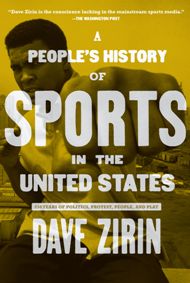 |
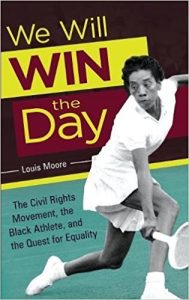 |
BooksA People’s History of Sports in the United States by Dave Zirin We Will Win the Day: The Civil Rights Movement, the Black Athlete, and the Quest for Equality by Louis Moore Many more books were recommended by the speakers and in the chat box. Those titles and more are on the Social Justice Books K-12+ booklist on sports. |
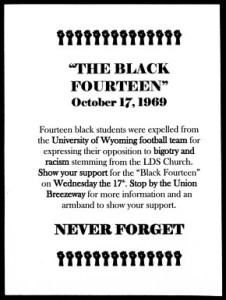 |
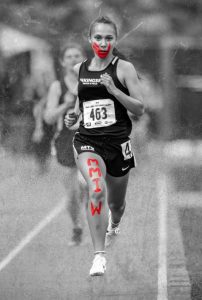 |
ArticlesHidden History of Strikes and Other Protests in College Sports by Dave Zirin Indigenous Runners Rosalie Fish and Jordan Marie Daniel Run for Their People by Eilís O’Neill on WBUR Sixty Years Ago She Refused to Stand for the Anthem: Before Colin Kaepernick kneeled, high jumper Rose Robinson defied tradition at the Pan American Games by Amira Rose Davis Student Athletes Kneel to Level the Playing Field by Jesse Hagopian in Rethinking Schools Maya Moore Left Basketball. A Prisoner Needed Her Help in New York Times WNBA Star Maya Moore Helped Overturn His Conviction in New York Times |
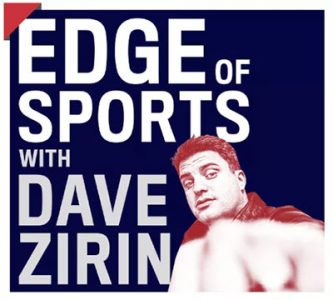 |
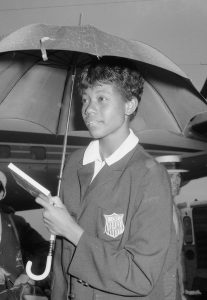 |
PodcastsEdge of Sports Where sports and politics collide, a weekly (Tuesdays) show hosted by Nation magazine sports editor Dave Zirin. On the Shoulders of Giants An episode of Throughline on the heavyweight boxer Jack Johnson, the sprinter Wilma Rudolph (in photo), and the basketball player Mahmoud Abdul-Rauf. |
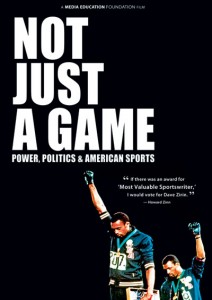 |
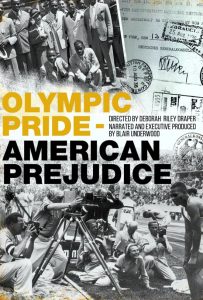 |
FilmsSee trailers of first three films further below. Not Just a Game: Power, Politics & American Sports by Dave Zirin Olympic Pride, American Prejudice directed by Deborah Riley Draper The Trials of Muhammad Ali by Bill Siegel What’s My Name | Muhammad Ali by Antoine Fuqua |
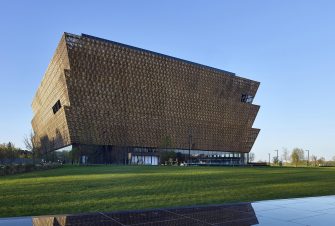 |
MuseumNational Museum of African American History and Culture (NMAAHC) The museum has an extensive permanent exhibit on sports in U.S. history called Leveling the Playing Field. |
|
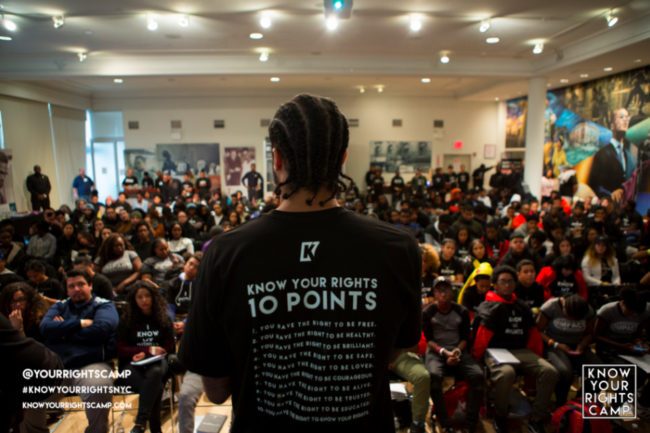 |
OrganizationsAthletes as Leaders A program for high school athletes on girls’ sports teams to empower student athletes to take an active role in promoting healthy relationships and ending sexual violence.
Athletes for Impact Providing a global network of athletes committed to equity and social change with the knowledge and information that they need to make informed decisions. Coaching Boys Into Men A prevention program for high school coaches on how to teach young male athletes healthy relationship skills and that violence never equals strength. Positive Coaching Alliance An organization dedicated to creating a positive, character-building youth sports environment. Set the Expectation Combating sexual and physical violence through education and direct engagement with coaches, young men and boys in high school, collegiate, and professional athletic programs. The Undefeated Online platform for exploring the intersections of race, sports, and culture. |
|
Film Clips
Not Just a Game
The Trials of Muhammad Ali
Participant Reflections
Here are some of the responses by participants from the session evaluation.
What was learned.
I would never consider myself a “sports” person and I was even a little hesitant in dropping into this specific session because. . . I don’t really like sports. I know that I’ve downplayed athletes and sports as important, but I’m walking away with books to read and an interest in how social justice movements work through and with athletes.
I appreciated learning about the women athletes who have resisted — I only knew Althea Gibson.
I really enjoyed hearing more about Robinson, Ali, and Tommy/John and the impact their activism had and continues to have. I will certainly feature these players/stories more heavily in my curriculum.
Everything was excellent and well-presented. David Zirin — yes! I like the idea of using sports as a frame for teaching history. So much is not known.
I learned so many names that I had never heard before. I hopefully will use this new knowledge to hook students who wouldn’t normally be interested in history. I also hope not to teach these athletes as individuals, but as important parts of a larger movement.
I wrote down tons of names to research more, and really appreciate ideas for framing sports history and culture, and transforming our patriarchal culture… wow! I will be incorporating as much as I can into new distance learning and hybrid learning units for the near future!
So many anecdotes, quotes, details, fascinating tidbits that drew me in and will draw my students in . . . . I want my students to see the connection between these amazing athletes and the broader movement they were a part of and how their actions on/off the field are hugely impactful to the larger civil rights movement.
Feeling a sense of permission to really explore this topic in my U.S. history class more than I have been.
So many great stories! I loved hearing about Muhammad Ali throwing his gold medal in the river. I enjoyed the discussion about the different ways black athletes have used their platform to advocate for change.
Oh my goodness. ALL of this is amazing!! My mind was blown on how much I just learned. Integrating sports into the curriculum is a very smart way to teach about labor movements and social justice issues. Connecting all these social justice pioneers to current events is so beneficial to understanding patterns in history.
There is a complexity of the human spirit and human experience that underlies sports.
Teach history — World and U.S. — through the lens of sports. It is also good to look at sports through the lens of capitalism and workers.
That there will be a Kaep award in the NFL is reminiscent of the ways in which people lie about their support for Ali and revulsion about the Vietnam War. My students will love it.
There were so many important stories shared today! The story about Wilma Rudolf really moved me and I’d never heard of Wyomia Tyus. Just having access to her name has shifted my understanding of the ways in which sports culture has shift race and gender relations in the United States.
Curt Flood Rule, Tiger Belles, all the Black figures who are obscure and the way all of this history was unpacked. Just absolutely BEAUTIFUL and would LOVE another session on this one!
Like with so much history, the wealth of activity by many ordinary people resisting, struggling, organizing, standing on principle and honor, made this so much more exciting than just again mentioning the famous names.
The idea that teaching history through the frame of sports gives students a way to ground their understanding, and also serves as a hook, was a big takeaway. Also, the way that Paul Robeson and Wyomia Tyus both supported/refused to criticize, or actually supported other people in the movement even when faced with exclusion or criticism. Those two stories stood out as particularly powerful.
Just so many things — particularly the details about the Olympic Black Power fist moment — I had no idea the backstory, the details and care that went into it, the before and after, down to the beads and buttons they wore and what it all stood for.
Loved the image analysis of John Carlos and Tommie Smith. At the beginning of the year we teach a unit on the Constitution and tie this in with anthem protests. I cannot wait to share the protests from the 1960s to help add to the narrative.
Dave Zirin was really inspiring and his sharing of resources is amazing for me. I am not much a fan of sports, but any way I can connect to students and adults is invaluable.
The format.
As readers can see from the responses below, most (but not all) participants like the mix of speakers, breakout rooms, and the chat box.
I like the breakout sessions to hear what others are doing.
Better amount of time in the breakout sessions this week!
Especially liked being able to process with breakout groups
It worked because Zirin was able to pack in a tremendous amount of material in a short time.
Wish we had more time with Dave Zirin, but I liked the breakout.
It was great! My participant group was a little quiet and the facilitator really kept it going. It was also REALLY cool to have a high school student (I’m a teacher) in the group sharing their thoughts and ideas.
I know there are time limits but I really wish we had more time to speak in our breakout rooms.
More breakout time needed!
I don’t love breakout groups.
Great presentation and back and forth with Jesse and Dave! I thought everything was great! This might be the best one I’ve been to so far.
I really appreciate the format, both the main room and the breakout sessions; the people in my breakout rooms are so inspiring and creative.
The format was great. I really enjoyed the break out session and the conversation between Jesse and David was fantastic.
Liked large and small sessions.
Would rather have listened to Dave Zirin instead of going to a breakout room. The breakout would have been better if people from similar occupations would be grouped together.
Dave is such an amazing wealth of information and I felt like this could have easily been twice as long.
Obviously we could spend hours on these topics making . . . time stop?
I liked the breadth of information shared from both past and present. Great resources.
This was a fabulously informative session. Thank you. It also was nice to have a small breakout just to build relationship, have time to process, and then return for the final question.
I am not a big fan of the breakout rooms. I wanted to hear more from this speaker. It’s good to see what other educators are doing but maybe shorten the time. There is a lot of awkward silence.
I loved it all. Particularly appreciated break out time to meet a small group of others interested in same matters. Although I had lived thru much of the history discussed re 1950’s, 60s, 70s, I learned new info.
You have the format just right.
Zirin is electric! His content knowledge, coupled with his enthusiasm, drew me in. The format was great as was the discussion in the break out group!
Of course, there needs to be a part two. I could listen to Dave drop knowledge for hours. Overall, the format is getting better and there was adequate time for the break out session.
All of the knowledge that Dave Zirin had, and the way he told it through stories, while making connections to broader themes, was awesome. I could have listened for a lot longer.
The format was really excellent, very accessible. I loved the whole group conversation, hearing dense/rich storytelling while simultaneously reading and engaging in dense/rich info-sharing in the chat . . . . The breakout groups came at the right time and it was nice to engage more with a small group and then return to the large group for more conversation. Perfect length as well.
Additional comments.
The conversation was incredible!
It’s easy to numb out to survive the stress during COVID-19. These workshops give me something to look forward and the learning and growing that takes place keeps me motivated as a learner and educator. Thank you!
Thanks, the conversation was incredible!
Jesse Hagopian is a national and regional treasure — so glad to have him in the Pacific Northwest!
Thanks so much for this! I just happened upon it via a Facebook post, and I’m so glad I jumped in.
Thank you! As usual, a highlight of my week!
I would love to have these weekly for the indefinite future even in the fall when we “go back to school” — THIS is the kind of engaging professional development I crave.
These have been amazing!! Thank you!!
Keep up the amazing work. Each week I am blown away at what I learn!
Presenters
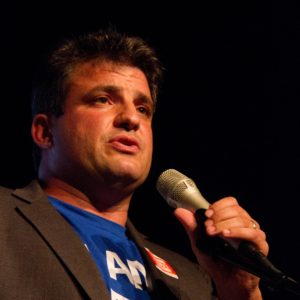 |
Dave Zirin is the sports editor for The Nation magazine and a frequent guest on Democracy Now! His books include Welcome to the Terrordome (Haymarket Books), A People’s History of Sports in the United States (New Press), and he is co-author of The John Carlos Story: The Sports Moment That Changed the World (Haymarket Books). He wrote the script for the film Not Just a Game: Power, Politics & American Sports. |
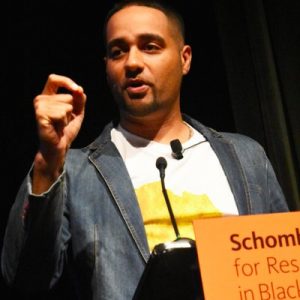 |
Jesse Hagopian teaches Ethnic Studies and is the co-adviser to the Black Student Union at Garfield High School in Seattle. He is an editor for Rethinking Schools, the co-editor of Teaching for Black Lives, and editor of More Than a Score: The New Uprising Against High-Stakes Testing. |






Twitter
Google plus
LinkedIn